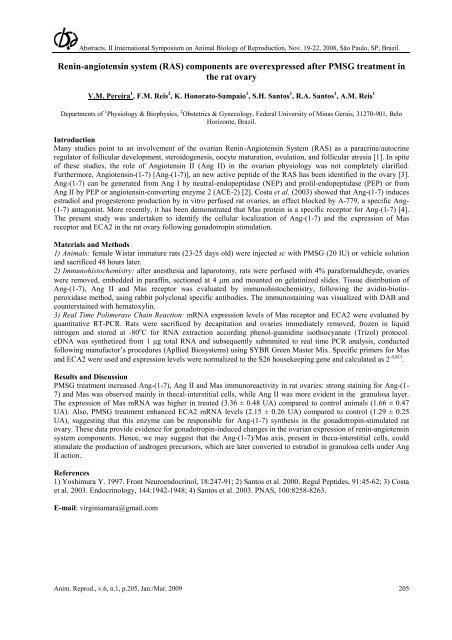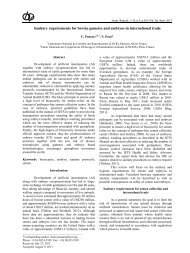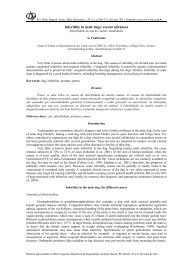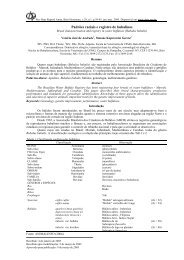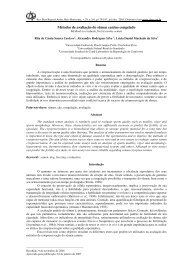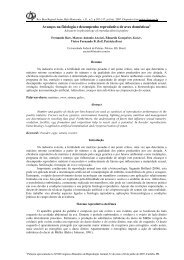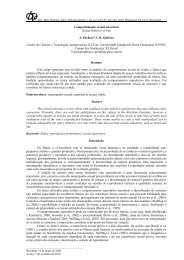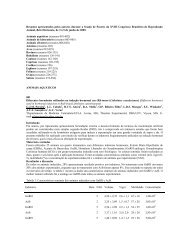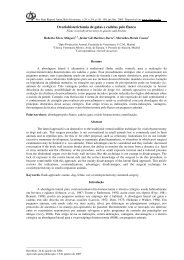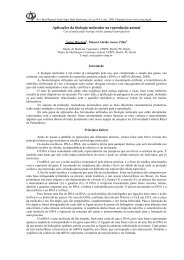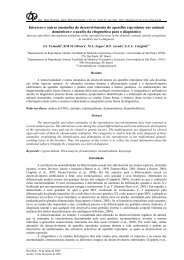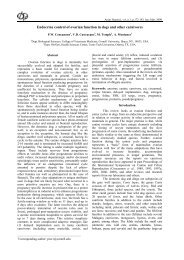Recent advances in ovulation synchronization and superovulation in ...
Recent advances in ovulation synchronization and superovulation in ...
Recent advances in ovulation synchronization and superovulation in ...
Create successful ePaper yourself
Turn your PDF publications into a flip-book with our unique Google optimized e-Paper software.
Abstracts. II International Symposium on Animal Biology of Reproduction, Nov. 19-22, 2008, São Paulo, SP, Brazil.<br />
Ren<strong>in</strong>-angiotens<strong>in</strong> system (RAS) components are overexpressed after PMSG treatment <strong>in</strong><br />
the rat ovary<br />
V.M. Pereira 1 , F.M. Reis 2 , K. Honorato-Sampaio 1 , S.H. Santos 1 , R.A. Santos 1 , A.M. Reis 1<br />
Departments of 1 Physiology & Biophysics, 2 Obstetrics & Gynecology, Federal University of M<strong>in</strong>as Gerais, 31270-901, Belo<br />
Horizonte, Brazil.<br />
Introduction<br />
Many studies po<strong>in</strong>t to an <strong>in</strong>volvement of the ovarian Ren<strong>in</strong>-Angiotens<strong>in</strong> System (RAS) as a paracr<strong>in</strong>e/autocr<strong>in</strong>e<br />
regulator of follicular development, steroidogenesis, oocyte maturation, <strong>ovulation</strong>, <strong>and</strong> follicular atresia [1]. In spite<br />
of these studies, the role of Angiotens<strong>in</strong> II (Ang II) <strong>in</strong> the ovarian physiology was not completely clarified.<br />
Furthermore, Angiotens<strong>in</strong>-(1-7) [Ang-(1-7)], an new active peptide of the RAS has been identified <strong>in</strong> the ovary [3].<br />
Ang-(1-7) can be generated from Ang I by neutral-endopeptidase (NEP) <strong>and</strong> prolil-endopeptidase (PEP) or from<br />
Ang II by PEP or angiotens<strong>in</strong>-convert<strong>in</strong>g enzyme 2 (ACE-2) [2]. Costa et al. (2003) showed that Ang-(1-7) <strong>in</strong>duces<br />
estradiol <strong>and</strong> progesterone production by <strong>in</strong> vitro perfused rat ovaries, an effect blocked by A-779, a specific Ang-<br />
(1-7) antagonist. More recently, it has been demonstrated that Mas prote<strong>in</strong> is a specific receptor for Ang-(1-7) [4].<br />
The present study was undertaken to identify the cellular localization of Ang-(1-7) <strong>and</strong> the expression of Mas<br />
receptor <strong>and</strong> ECA2 <strong>in</strong> the rat ovary follow<strong>in</strong>g gonadotrop<strong>in</strong> stimulation.<br />
Materials <strong>and</strong> Methods<br />
1) Animals: female Wistar immature rats (23-25 days old) were <strong>in</strong>jected sc with PMSG (20 IU) or vehicle solution<br />
<strong>and</strong> sacrificed 48 hours later.<br />
2) Immunohistochemistry: after anesthesia <strong>and</strong> laparotomy, rats were perfused with 4% paraformaldheyde, ovaries<br />
were removed, embedded <strong>in</strong> paraff<strong>in</strong>, sectioned at 4 μm <strong>and</strong> mounted on gelat<strong>in</strong>ized slides. Tissue distribution of<br />
Ang-(1-7), Ang II <strong>and</strong> Mas receptor was evaluated by immunohistochemistry, follow<strong>in</strong>g the avid<strong>in</strong>-biot<strong>in</strong>peroxidase<br />
method, us<strong>in</strong>g rabbit polyclonal specific antibodies. The immunosta<strong>in</strong><strong>in</strong>g was visualized with DAB <strong>and</strong><br />
countersta<strong>in</strong>ed with hematoxyl<strong>in</strong>.<br />
3) Real Time Polimerase Cha<strong>in</strong> Reaction: mRNA expression levels of Mas receptor <strong>and</strong> ECA2 were evaluated by<br />
quantitative RT-PCR. Rats were sacrificed by decapitation <strong>and</strong> ovaries immediately removed, frozen <strong>in</strong> liquid<br />
nitrogen <strong>and</strong> stored at -80 o C for RNA extraction accord<strong>in</strong>g phenol-guanid<strong>in</strong>e isothiocyanate (Trizol) protocol.<br />
cDNA was synthetized from 1 μg total RNA <strong>and</strong> subsequently submmited to real time PCR analysis, conducted<br />
follow<strong>in</strong>g manufactor’s procedures (Apllied Biosystems) us<strong>in</strong>g SYBR Green Master Mix. Specific primers for Mas<br />
<strong>and</strong> ECA2 were used <strong>and</strong> expression levels were normalized to the S26 housekeep<strong>in</strong>g gene <strong>and</strong> calculated as 2 -ΔΔCt .<br />
Results <strong>and</strong> Discussion<br />
PMSG treatment <strong>in</strong>creased Ang-(1-7), Ang II <strong>and</strong> Mas immunoreactivity <strong>in</strong> rat ovaries: strong sta<strong>in</strong><strong>in</strong>g for Ang-(1-<br />
7) <strong>and</strong> Mas was observed ma<strong>in</strong>ly <strong>in</strong> thecal-<strong>in</strong>terstitial cells, while Ang II was more evident <strong>in</strong> the granulosa layer.<br />
The expression of Mas mRNA was higher <strong>in</strong> treated (3.36 ± 0.48 UA) compared to control animals (1.66 ± 0.47<br />
UA). Also, PMSG treatment enhanced ECA2 mRNA levels (2.15 ± 0.26 UA) compared to control (1.29 ± 0.25<br />
UA), suggest<strong>in</strong>g that this enzyme can be responsible for Ang-(1-7) synthesis <strong>in</strong> the gonadotrop<strong>in</strong>-stimulated rat<br />
ovary. These data provide evidence for gonadotrop<strong>in</strong>-<strong>in</strong>duced changes <strong>in</strong> the ovarian expression of ren<strong>in</strong>-angiotens<strong>in</strong><br />
system components. Hence, we may suggest that the Ang-(1-7)/Mas axis, present <strong>in</strong> theca-<strong>in</strong>terstitial cells, could<br />
stimulate the production of <strong>and</strong>rogen precursors, which are later converted to estradiol <strong>in</strong> granulosa cells under Ang<br />
II action.<br />
References<br />
1) Yoshimura Y. 1997. Front Neuroendocr<strong>in</strong>ol, 18:247-91; 2) Santos et al. 2000. Regul Peptides, 91:45-62; 3) Costa<br />
et al. 2003. Endocr<strong>in</strong>ology, 144:1942-1948; 4) Santos et al. 2003. PNAS, 100:8258-8263.<br />
E-mail: virg<strong>in</strong>iamara@gmail.com<br />
Anim. Reprod., v.6, n.1, p.205, Jan./Mar. 2009 205


